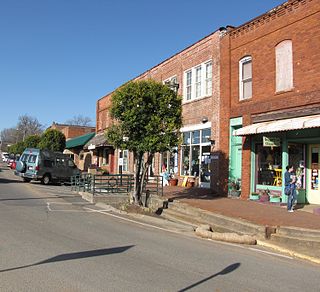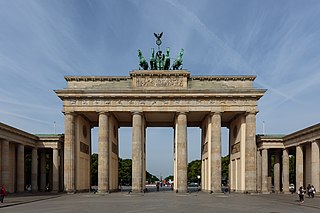Rockford is an unincorporated community and former town in southern Surry County, North Carolina.

The Masonic Temple Building located at 133 Fayetteville Street in Raleigh, North Carolina was the state's first reinforced concrete skyscraper. Constructed in 1907 by Masons, the building represents the growth of Raleigh in the early 20th century and rise of the influence of Masons. The Masonic Temple Building was added to the National Register of Historic Places in 1979 and is a Raleigh Historic Landmark.

The Masonic Temple Building, built in 1907, is an historic Prince Hall Masonic building located at 427 South Blount Street in Raleigh, North Carolina. It is a three-story, red brick flat roofed building. It has a metal cornice at the top of the first floor level and a cast iron Corinthian order column at the corner. On May 3, 1984, it was added to the National Register of Historic Places.
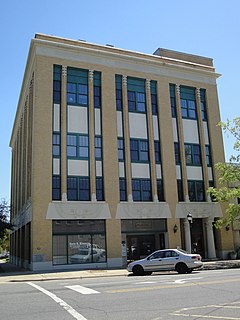
The Masonic Temple is a historic Masonic Lodge and office building located at Shelby, Cleveland County, North Carolina. It was built in 1924-1925, and is a four-story, rectangular, brushed brick building. It is in the Egyptian Revival style with massive concrete lintels at the first story, robust lotiform pillars at the building's principal entrance, and a richly ornamented cornice frieze. It was commissioned by the Cleveland Lodge of the Ancient, Free, and Accepted Masons of North Carolina. Today, no Masonic lodges meet in the building.

The Bank of Onslow and the Jacksonville Masonic Temple are two adjoining historic buildings located at 214 and 216 Old Bridge Street, in Jacksonville, Onslow County, North Carolina. The buildings are in the Beaux Arts architecture and Tudor Revival architecture, and were constructed in 1916, and 1919 respectively. They were jointly listed on the National Register of Historic Places in 1989 as a national historic district.
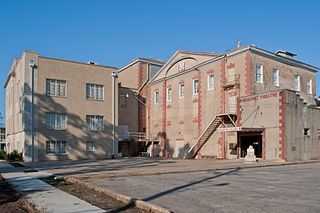
The Masonic Temple, also known as St. John's Lodge No. 3, A.F. & A.M., is a historic Masonic temple and theatre located at 516 Hancock Street in New Bern, Craven County, North Carolina. It was built between 1802 and 1809, with additions and several alterations. The original section is a very tall, two-story Federal style brick structure, seven bays wide by four bays deep. It sits on a high basement and has a hipped roof. A major addition was made in 1904, and the building was remodeled in 1847 and in 1917. The site was the scene of a duel in 1802.

Pittsboro Presbyterian Church is a historic Presbyterian church located on N. East Street in Pittsboro, Chatham County, North Carolina. It was built about 1850, and is a one-story brick church. The tower and steeple were replaced in 1875 following a tornado, and again in the 1920s and in 1971.
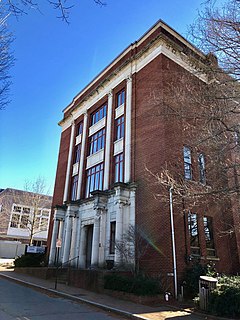
The Masonic Hall in Waynesville, North Carolina is a historic Masonic Lodge constructed in 1927 as a meeting hall for a local area Masonic Lodge.

Kelvin was a historic home located at Pittsboro, Chatham County, North Carolina. It was built about 1831, was a two-story, five bay Federal style single pile frame dwelling. The house had a gable roof and exterior end chimneys. It had a one-story addition built about 1838. It originally housed a private girls school established by wealthy landowner Colonel Edward Jones Kelvin. It has been demolished.

McClenahan House is a historic home located at Pittsboro, Chatham County, North Carolina. It was built before 1830, and is a one-story, three bay, frame dwelling on a brick foundation with Greek Revival and Federal style design elements. The house began as a one-room house and is one of only four buildings in Pittsboro that dates from the settlement era.

Moore-Manning House is a historic home located at Pittsboro, Chatham County, North Carolina. It was built in the 1830s, and is a two-story, three bay, Federal style frame dwelling with a hipped roof. The house was renovated in 1858 and a two-story wing added.

Reid House is a historic home located at Pittsboro, Chatham County, North Carolina. It was built about 1850, and is a 1 1/2-story, three bay, Federal / Greek Revival style double-pile plan frame dwelling. It has a broad gable roof and two interior chimneys. The house was renovated in the 1930s.

Patrick St. Lawrence House, also known as the Yellow House, is a historic home located at Pittsboro, Chatham County, North Carolina. It was built about 1787, and is a two-story, five bay, Federal / Greek Revival style frame dwelling with a low gable roof. It was originally built as an inn and overlooked the courthouse square. It is Pittsboro's oldest building. It was moved to its present site in 1955.
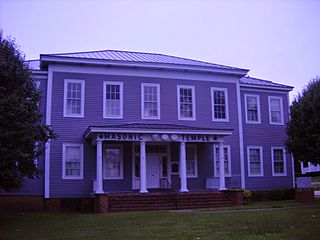
Phoenix Masonic Lodge No. 8 is a historic Masonic Lodge located at Fayetteville, Cumberland County, North Carolina. It was built about 1855, and is a two-story, five bay, Greek Revival style frame building with a hip roof. It has flanked by wings added 1948–1950 and features a front porch supported by octagonal columns.

Adoniram Masonic Lodge is a historic Masonic Lodge located near Cornwall, Granville County, North Carolina. It was built in 1917, and is a two-story, four-bay, one-room-deep, I-house style frame building. It features a full-width porch with enclosed end bays adorned with turned posts and feathery cut brackets. It housed a public school between 1917 and 1923. The building was moved to its present location in 1948.

The Clarke–Hobbs–Davidson House, also known as the Masonic Temple and Charles A. Hobbs House, is a historic home located at Hendersonville, Henderson County, North Carolina. It was built about 1907, and is a two-story, brick, transitional Queen Anne / Colonial Revival style dwelling. A rear brick addition was built about 1958, after it was acquired by the Masons for use as a Masonic Lodge. It features a one-story hip roofed full-width porch and a tall deck-on-hip roof.
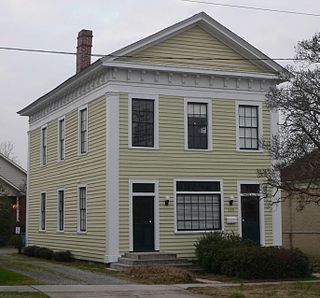
Smithfield Masonic Lodge, also known as the Brooks Building, is a historic Masonic Lodge located at Smithfield, Johnston County, North Carolina. It was built about 1854, and moved to its present location in 1915-1917. It is a two-story, three bay, rectangular vernacular Greek Revival style frame building. It has a gable front temple form and is sheathed in plain weatherboard. Fellowship Lodge No. 84 occupied the building until the 1940s, and the Smithfield Woman's Club met in the building from 1917 through 1933. The building house Smithfield's first public library operated by the Smithfield Woman's Club.

The Asheville Masonic Temple is a Masonic Temple located in Asheville, North Carolina. Designed by British American architect and Freemason Richard Sharp Smith, the building was opened in April 1915. It is listed in the United States National Register of Historic Places as a contributing building in the Downtown Asheville Historic District.

Holly Springs Masonic Lodge is a historic Masonic Lodge located at Holly Springs, Wake County, North Carolina. It was built about 1852, and is a two-story, Greek Revival influenced frame building with a side gable roof. It has a one-story, hip roofed front porch. In addition to being a Masonic Lodge, the building also housed a school.

